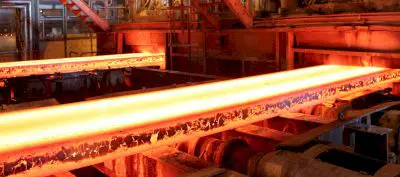There are 62 types of minerals in Iran, of which 6 billion tons of proven metal reserves have been calculated, while over 5 billion tons of potential metals reserves in addition to the mentioned definite reserves have been estimated in Iran

Iran's location in one of the most important mountain ranges in the world between the Himalayas and the Alps and having orogenic conditions has caused Iran to have 10 types of mineral reserves that are the first in the world. There are 62 types of Minerals in Iran, of which 6 billion tons of proven Metal reserves have been calculated, while over 5 billion tons of potential Metals reserves in addition to the mentioned definite reserves have been estimated in Iran.
Iran has significant Copper deposits, with mines located in various regions such as Kerman, Sistan and Baluchestan, and East Azerbaijan. The country's copper reserves are among the largest globally. Copper mining and production support various industries, including construction, electrical equipment manufacturing, and telecommunications. Iran possesses substantial iron ore deposits, particularly in the central and northeastern parts of the country. The Chadormalu and Gol Gohar mines are major iron ore producers. Iran's iron ore resources are of high quality and are used extensively in the Steel industry for the production of steel and related products.
Iran has extensive Zinc deposits, primarily located in the provinces of Yazd, Zanjan, and East Azerbaijan. The country is one of the top zinc producers globally. Zinc is used in a wide range of applications, including galvanizing steel, manufacturing alloys, and producing zinc-based chemicals. Iran has Bauxite deposits and Aluminum production facilities. The Jajarm and North Hormozgan mines are among the significant bauxite sources in the country. Iran's aluminum industry includes the production of primary aluminum and downstream aluminum products, supporting sectors such as construction, automotive, and packaging.
Iran has lead deposits, primarily found in the central and western parts of the country. The Anguran and Mehdiabad mines are notable sources of lead. Lead is used in various industries, including batteries, construction, and ammunition manufacturing. Iran has Gold deposits, particularly in the eastern and northeastern regions of the country. The Zarshuran and Sari Gunay mines are among the significant gold producers. Gold mining and production contribute to Iran's economy and support the Jewelry and investment sectors. Iran has a well-established steel industry. The country has integrated steel mills and rolling mills that produce a wide range of steel products, including rebar, sheets, sections, and wire rods. The steel industry plays a vital role in Iran's construction, manufacturing, and infrastructure development sectors.
Iran, a country located in the Middle East, is rich in mineral resources and has a diverse range of metals. Iran has significant copper deposits, with mines located in various regions such as Kerman, Sistan and Baluchestan, and East Azerbaijan. The country's copper reserves are among the largest globally. Copper mining and production support various industries, including construction, electrical equipment manufacturing, and telecommunications. Iran possesses substantial iron ore deposits, particularly in the central and northeastern parts of the country. The Chadormalu and Gol Gohar mines are major iron ore producers. Iran's iron ore resources are of high quality and are used extensively in the steel industry for the production of steel and related products.
Iran has bauxite deposits and aluminum production facilities. The Jajarm and North Hormozgan mines are among the significant bauxite sources in the country. Iran's aluminum industry includes the production of primary aluminum and downstream aluminum products, supporting sectors such as construction, automotive, and packaging. Iran has lead deposits, primarily found in the central and western parts of the country. The Anguran and Mehdiabad mines are notable sources of lead. Lead is used in various industries, including batteries, construction, and ammunition manufacturing. Iran has gold deposits, particularly in the eastern and northeastern regions of the country. The Zarshuran and Sari Gunay mines are among the significant gold producers. Gold mining and production contribute to Iran's economy and support the jewelry and investment sectors.
Iran has a well-established steel industry. The country has integrated steel mills and rolling mills that produce a wide range of steel products, including rebar, sheets, sections, and wire rods. The steel industry plays a vital role in Iran's construction, manufacturing, and infrastructure development sectors. Iran also possesses other metal resources, including nickel, cobalt, tin, and rare earth elements. While the production of these metals may be limited compared to other resources, their presence offers potential opportunities for future development and exploration.
Iran's metal industry is supported by government initiatives, investment incentives, and infrastructure development. The country aims to enhance the value chain of its metal sector, increase local value addition, and attract foreign investment. Collaboration with international partners and technology transfer also play a role in developing Iran's metal industry. It's important to note that while Iran has significant metal resources, the country faces challenges due to economic sanctions and geopolitical factors that impact its metal industry's growth and international collaborations. However, Iran continues to focus on utilizing its metal resources for domestic consumption and export opportunities within the framework of its national priorities and regulations.
ran has extensive zinc deposits, primarily located in the provinces of Yazd, Zanjan, and East Azerbaijan. The country is one of the top zinc producers globally. Zinc is used in a wide range of applications, including galvanizing steel, manufacturing alloys, and producing zinc-based chemicals. Steel production capacity in Iran reaches 10 million tons per year. Iran's copper mines contain 2 billion tons of ore with an average grade of three and seven-tenths percent. Iran has five percent of the world's proven copper reserves, 98 percent of the Middle East's copper reserves, and 30 percent of Asia's copper reserves. Iran produces 150,000 tons of aluminum per year, which is the largest producer of aluminum in the Middle East. Iran is very rich in zinc ores and extensive studies show that the volume of Iran's lead and zinc mineral reserves is about 230 million tons.





